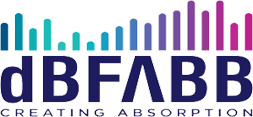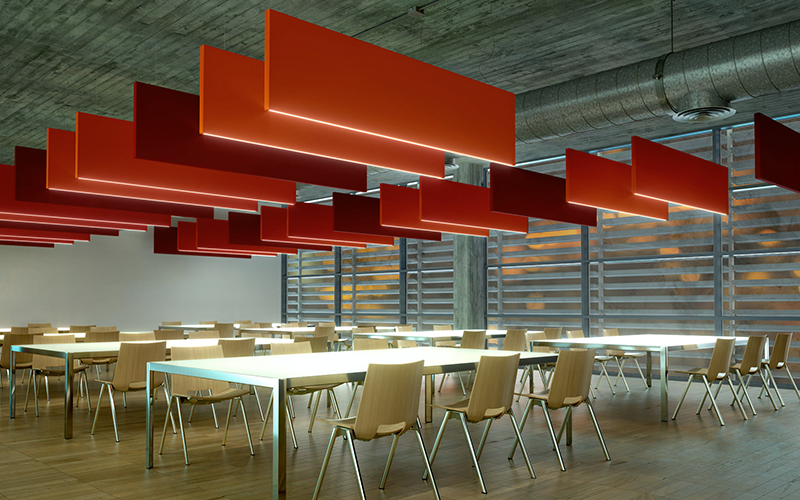
STRETCH FABRIC ACOUSTIC
Creating a comfortable acoustic environment is often overlooked when designing interiors. In modern buildings there are an increasing number of hard surfaces which cause sound to bounce or reverberate around a room. The result of this is increased sound propagation and excess noise levels. Our 50mm thick system uses a class ‘A’ sound absorbing acoustic core to absorb sound waves, meaning that our installations can absorb over 90% of sound that hits them. The result of this is a significant reduction in reverberation times (RT) and the creation of a comfortable acoustic environment. The outcome of this is that users will become less fatigued, will be able to concentrate for longer and speaker phones and video conferencing equipment will function properly.
Below is a table showing the results of the acoustic testing data with noise reduction coefficient (NRC) for both the 25mm & 50mm depth systems using a standard breathable fabric and glass-fibre sound absorbing core. The 50mm thick system achieves absorption Class A, the very highest rating in sound absorption in accordance with the international standard EN ISO 11654. The 25mm thick system achieves an NRC of 0.85.
| Frequency | 63 | 125 | 250 | 500 | 1000 | 2000 | 4000 | 8000 | IRC | Alpha w | Class |
|---|---|---|---|---|---|---|---|---|---|---|---|
| 25mm Tickness | 0.15 | 0.23 | 0.63 | 0.93 | 0.90 | 0.98 | 1.04 | 1.13 | 0.85 | 0.90 | A |
| 50mm Thickness | 0.28 | 0.39 | 1.04 | 1.09 | 1.09 | 1.13 | 1.16 | 1.17 | 1.10 | 1.00 | A |
Glossary of terms used above: -
Noise Reduction Coefficient (NRC): The NRC is a single-number index determined in a lab test and used for rating how absorptive a particular material is. This industry standard ranges from zero (perfectly reflective) to 1* (perfectly absorptive). It is simply the average of the mid-frequency sound absorption coefficients (250, 500, 1000 and 2000 Hertz) rounded to the nearest 5%.
Reverberation Time (RT60): The time required, in seconds, for the average sound in a room to decrease by 60 dB after the source stops emitting sound. Reverberation Time is affected by the size of the space and the amount of reflective or absorptive surfaces within that space. Highly sound absorbent surfaces will prevent it from reflecting back into the space, providing shorter reverberation times. Reflective surfaces will reflect the sound and increase the reverberation time within the space. Larger spaces generally have longer reverberation times than smaller spaces and require more sound absorbent materials to achieve the same reverberation time as a smaller space.
Speech Intelligibility. The clarity of speech in a room is dependent on the level of background noise, reverberation time and room shape. Speech intelligibility is typically measured in rooms using the Rapid Speech Transmission Index (RASTI). A transmitter broadcasts a modulated noise signal from a loudspeaker, and a microphone receiver measures the clarity of the noise at the receiver position and gives a read-out of the RASTI value.
Sound Absorption Class A-E: Weighted sound absorption coefficient αw values are compared to a series of fixed reference curves, providing a general indication of the sound absorption capability of the material. Absorption Classes A-E are described in international standard EN ISO 11654.
dBFabb is site-fabricated by our specialist installers who have a wealth of experience and techniques to ensure the very highest standard of finish. We have provided the best training for our technicians and invested in the highest quality installation tools and blades. Special care is taken to ensure that the fabric weave is kept straight and consistent. The dBFabb installation is carried out in number of stages, a broad summary of which is detailed below:
-
-
- Wall dimensions are accurately measured before cutting of perimeter and mid-rail track.
- Wall area is marked with vertical and horizontal joint locations.
- Track us accurately cut and mitered at intersecting locations.
- Perimeter track is pre-wrapped in the chosen fabric if required.
- Perimeter and mid-rail track is securely fixed to wall using compressor powered staple gun.
- Sound absorbing core material is cut to size and installed tightly inside track extrusions.
- Fabric is cut 100mm to 150mm wider and longer than track centers.
- Fabric is tacked into the center of the top and then bottom tracks.
- Fabric is tucked into the track outwardly from the center of the top and bottom track.
- Same fabric tucking method applies to the vertical tracks.
- When all sides are tucked in, scissors are used to trim excess fabric to 10mm.
- The final 10mm of fabric is then tucked into the track.
-
dBFabb is not constrained to size (size is defined by the fabric). Our installations do not require exact site measuring which eliminates delays waiting for prefabricated acoustic panel products, so installation can begin as soon as the site is ready and the fabric is available.
The dBFabb system has excellent environmental credentials. The core materials we use are fully recyclable and are made from over 80% recycled content. The majority of fabrics we recommend and specify have been awarded EU Ecolabel (or equivalent). A large number of fabrics we use are also accepted by LEED (Leadership in Energy & Environmental Design).

Track
The Track is the concealed framework that holds the fabric tight and in place. Track is available in 12mm, 25mm and 50mm thicknesses with square, radius and bevelled profile options.

Core
The Core is the unseen sound absorbing element in the system. We use rigid glass-fibre slabs or high-performance acoustic foam. Sound absorbing cores are all acoustically tested with our system.

Fabric
Fabric is the visual element in the system. dBFabb is compatible with almost any fabric. Patterns and custom fabrics can also be used and we can create custom shapes and meet the contours of unique walls






